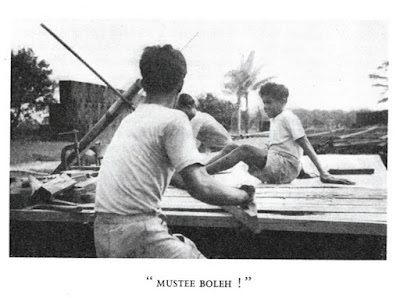It indeed caught on as battle cry during major sporting events participated by Malaysian athletes. Due to OCM being affiliated to the government, the slogan is somehow viewed to signify the government's fascination of building high (Petronas Twin Towers), long (Penang Bridge) and big (KL International Airport). On the negative side, due to overuse it became a major cliché and developed into deriding compound words such as "Bolehwood", “Bolehville” and "Bolehland" to describe wastages and excesses, as well as the Malaysian culture that accepts bending of rules and laws.
In my view the origin of the battle cry "... Boleh!" can be traced even further back in time than the 80s "Milo Boleh!" slogan. In particular, it can be traced to a 1949 yacth named 'Boleh' built by Terengganu Malay shipwright Embong bin Salleh and his assistants Ali Bin Ngah, Wan Ali & Awang at the British Naval Base in Loyang, Singapore.
It is unclear as to how the name Boleh was chosen. Perhaps it was to personify her owner's intention to sail her from Singapore all the way to England. Nevertheless, the owner and designer, Naval Commander Robin Kilroy DSC, did write an account of her construction and subsequent 14,000 mile journey to England in his book titled "Boleh".
Robin recorded that despite numerous failures and broken pieces the lead shipwright would not stop in his effort until the job is done, uttering the word "Mustee Boleh!" ("Sure Can!") in each and every attempt.
It took 8 1/2 months for Boleh to reach Salcombe. According to Robin, he received a letter from Embong bin Salleh once he arrived in England. Embong wrote that he and Ali bin Ngah were very proud when they heard about Boleh's arrival in Salcombe. According to Embong, he was then busy building Police launches at the East Coast of Malaya.
As to Boleh's fate, she was used to train Sea Cadets and sailing club members in Salcombe. In 1978 she was severely damaged by arson and declared an insurance write-off.
She was rebuilt by its new owner, Roger Angel. In 1980s, Boleh came to rest in Spain where her lines and rig became a familiar sight; her berth at Real Club Nautico gave the name Shanghai Quay to one of the the club's jetties in Palma.
In 2007 increasing ill health led Roger to look to sell Boleh and, by a happy chance, this coincided with Robin Kilroy’s family seeking to safeguard the vessel’s future.
After an eventful life, Boleh was restored in 2008. Boleh is now a working heritage vessel based in Chichester Harbour, England. She is listed as a protected heritage item in the UK’s National Register of Historic Vessels (No. 2281). She is managed by The Boleh Trust which is jointly funded by the National Historic Ships Fund & the Heritage Lottery Fund.













.jpg)
No comments:
Post a Comment